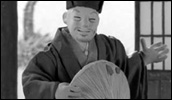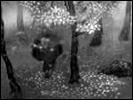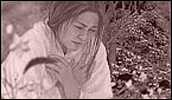Winter Days
- Year
- 2003
- Original title
- Fuyu no Hi
- Japanese title
- 冬の日
- Director
- Running time
- 105 minutes
- Published
- 16 March 2008



by Catherine Munroe Hotes
Japanese poetry and ideogrammatic language has inspired Western filmmakers and poets for at least a century. Sergei Eisenstein cited Japanese poetry when he expounded his theory of montage and Russian filmmaker Andrei Tarkovsky felt that haiku, in its simplicity and accuracy of image, came the closest to what he considered the truth of cinema: "direct observation of life."
Adaptations of poems or the creation of film poems have usually been the mainstay of avant-garde and experimental filmmakers from Maya Deren to Stan Brakhage. Such artists aspire to create a kind of 'pure cinema' by evoking meaning through image and sometimes sound, rather than story. Examples of contemporary Japanese artists creating poetic films include Mika Seike, Tomoyasu Murata, Tabaimo, and Kei Oyama.
Winter Days, an adaptation of a renga by Basho, is a unique project in terms of scale. Renga is a collaborative form of poetry involving a minimum of three poets. The original poem Winter Days involved six poets (Basho, Yasui, Kakei, Jugo, Tokoku, Shohei, and Yasui) who alternated contributing verses. Kihachiro Kawamoto and Tatsuo Shimamura took on the daunting task of assembling an impressively diverse group of 35 animators, including themselves, to make the 36 short films required. Kawamoto is of course renowned for his puppet animations such as The Book of the Dead (2005) and Shimamura also has an impressive history working in animation as both an animator and a producer.
The selection of filmmakers showcases a wide range of styles and techniques from cel animation (Tatsutoshi Nomura) to CGI (Fumio Ooi), and from the humorous (Yoji Kuri) to the hauntingly surreal (Keita Kurosaka). The film features seven non-Japanese animators including Yuri Norstein (Russia), Raoul Servais (Belgium), Alexandr Petrov (Russia), Bretislav Pojar (Canada/Czech Republic), Mark Baker (UK), Co Hoedeman (Canada/Netherlands), and Bairong Wang (China). Usually under-represented in animation, several women artists are also present in Winter Days, including Noriko Morita, Maya Yonesho, Azuru Isshiki, Reiko Yokosuka, Yuko Asano, and Fusako Yusaki. There are also three films designed by husband-wife teams: Yoichi Kotabe and Reiko Okuyama, who have both worked in mainstream anime, Uruma Delvi, who specialize in quirky short Flash animations, and I.K.I.F. (Tokomitsu Kifune and Sonoko Ishida) who specialize in doing 3D CG-effects for mainstream anime.
Kawamoto, as host, contributes the second film and the closing film of the series. The producers honoured Yuri Norstein with the opening film and the longest running time. Norstein is highly regarded by the animation and children's literature communities in Japan and he has visited Japan on many occasions. Most of the shorts run between 30 and 60 seconds, but Norstein's runs for 110 seconds. Norstein sets the tone for the film as a whole by retaining his unique animation style while at the same time effectively distilling the tone and imagery of the original poem. The autumn colours give the film a kind of warmth, while the character movement adds humour and charm.
Norstein sets the standard pretty high for the animators who follow, and while several of the films equal his mastery of the medium, many fall short in contrast. While the project is impressive in its scope, there is a lack of fluidity between the films. One gets the impression that some of the artists may have joined the project just to get their work featured in an omnibus that would likely do the international festival circuit, while others clearly did their research about the tone and style of the poem and remained true to the images and themes. In renga, each verse must make sense independently, but it must also connect in some way with the verses that precede and follow it. Some sections of the film acheve this better than others.
The best example of good continuity of tone and style are the first half dozen short films. Norstein's film depicts, with humour, an encounter between Chikusai and Basho. Norstein picks up on the seasonal reference to late autumn and ends his film with Basho starting his journey by walking into the wind, holding onto his straw hat to keep it from being blown away. Kawamoto picks up where Norstein left off with windy, autumnal imagery and Basho arriving in his straw hat to a meeting of his fellow poets. Kawamoto adds a shower of pink heart-shaped sasanqua petals (an evergreen flowering shrub native to southern Japan and common in Japanese gardens), the key image of the second stanza of the poem. In the third film, Fumio Ooi references the traveler in the straw hat and the sasanqua petals falling like snow from the sky, and adds the sake brewery of the third stanza. The fourth film opens with an abrupt shift to a modern image but soon Tatsutoshi Nomura reveals that the truck outside the sake brewery is an allusion to horse power and the fiery image of the horse is picked up in the following film by Shinichi Suzuki who also uses modern images in combination with traditional images.
When it comes to poetic film, traditional styles of animation like cel animation and stop motion tend to be more successful than computer animation. 'Handmade' films tend to have more texture and depth of emotion that are vital in the creation of poetic meaning. This is not to say that CGI technology is incapable of producing a poetic image, but that it needs to be used prudently. Many of the films, like that of Shimamoto, drew the images first by hand, then used the computer for editing and adding special effects thereby creating visually stunning results. In contrast, although Ooi used carefully considered images that fit with the films that preceded and followed his, the solely computer-generated images had a cold emotionless quality to them that rendered the sequence too prosaic. Uruma Delvi's sequence also disappointed. Their round-headed Flash-generated characters are much more suited to their humorous shorts like Bottom Biting Bug (Oshiri Kajiri Mushi, 2007) and did not really fit the themes of Winter Days. Mark Baker's sequence also featured his usual character style, suddenly transporting us to the English setting of The Big Knights (which Baker co-directed with Neville Astley, 1999) before landing back with a crash into one of Yuichi Ito's surreal landscapes. The effect was jarring despite the continuity of music and the narrated inter-titles between each filmic stanza.
The films that impress most are the ones by animators who have a long history in mainstream media but chose to use Winter Days as an opportunity to challenge themselves artistically. Isao Takahata's sequence gives a nod to traditional Japanese art but with some toilet humour (quite literally) injected at the end. Yoichi Kotabe and Reiko Okuyama created a beautiful film that was far removed from the big-budget anime they have each worked on in the past. Other stand-outs were the films by Raoul Servais, Keita Kurosaka, Reiko Yokosuka, Masaaki Mori, Co Hoedeman, and Jacques Drouin.